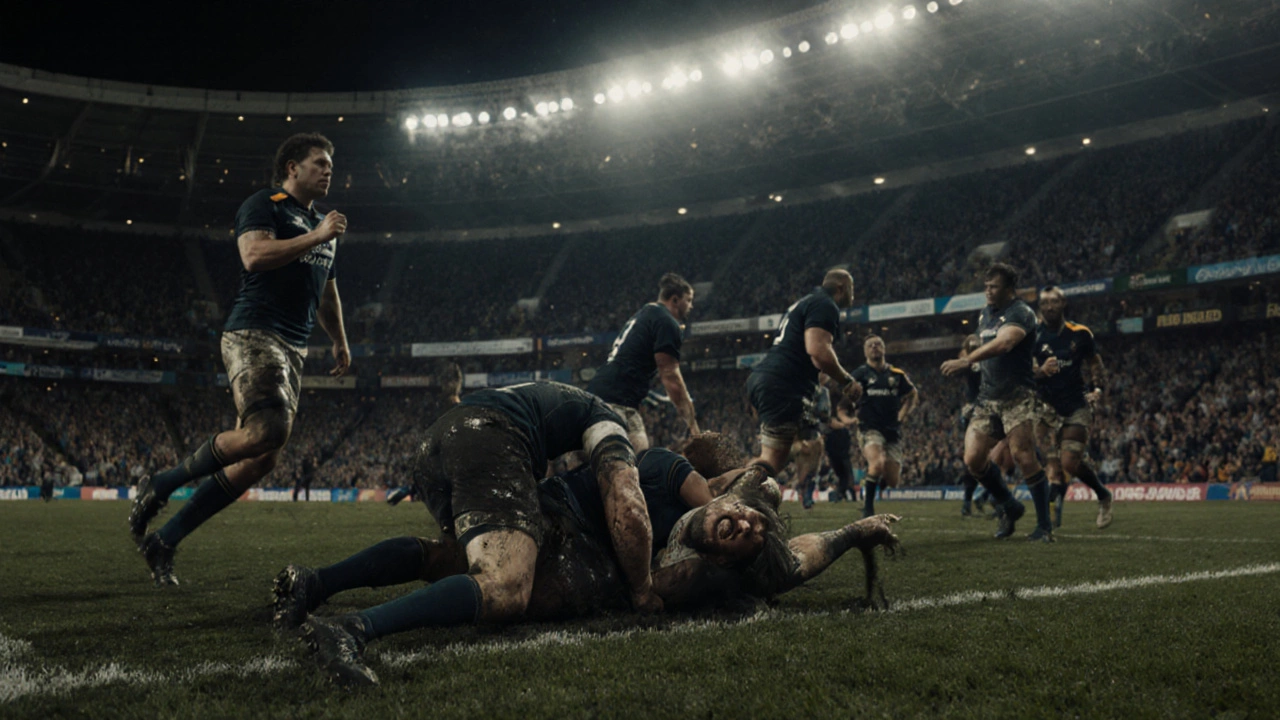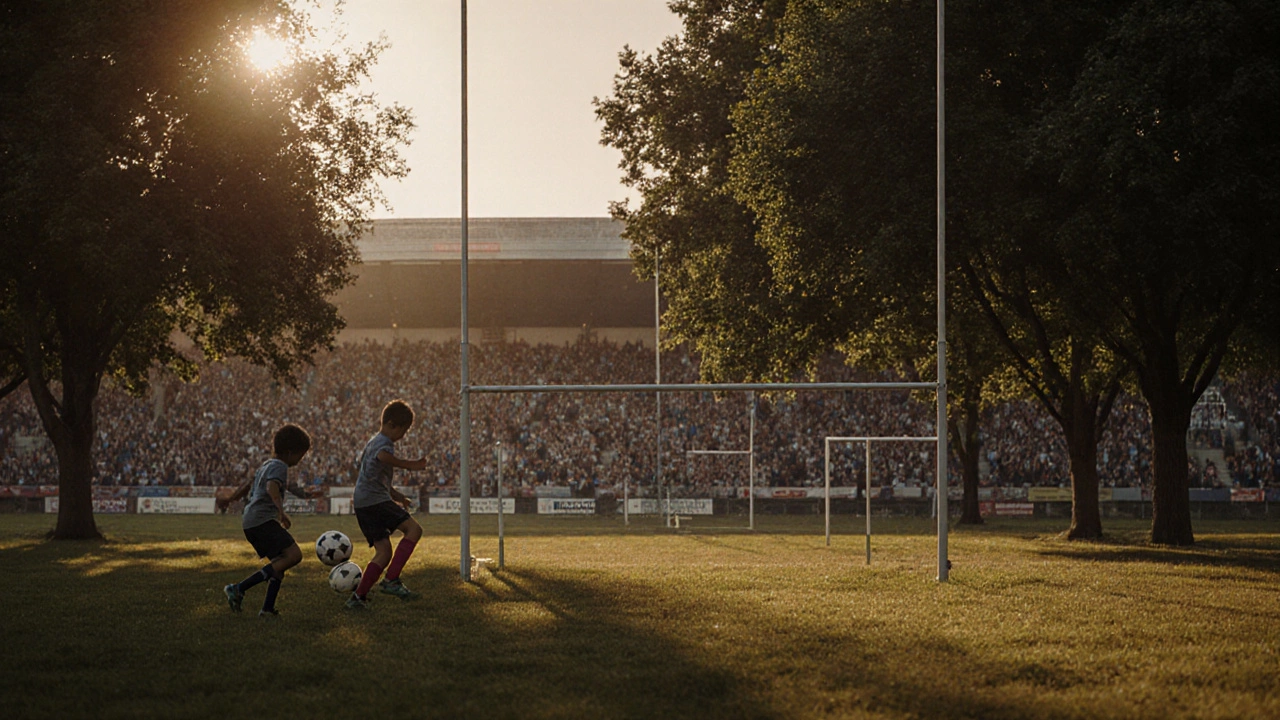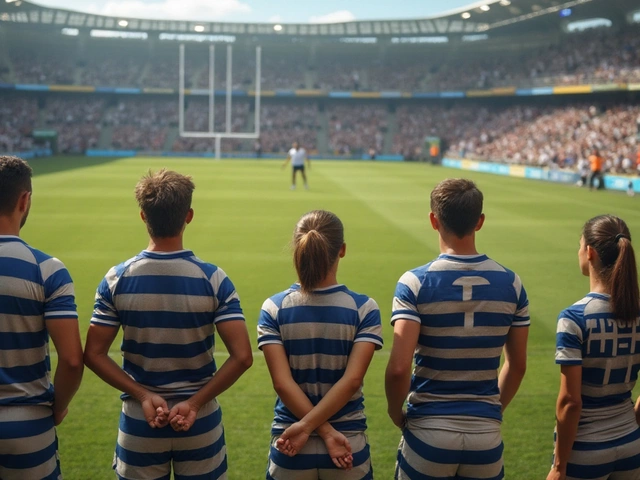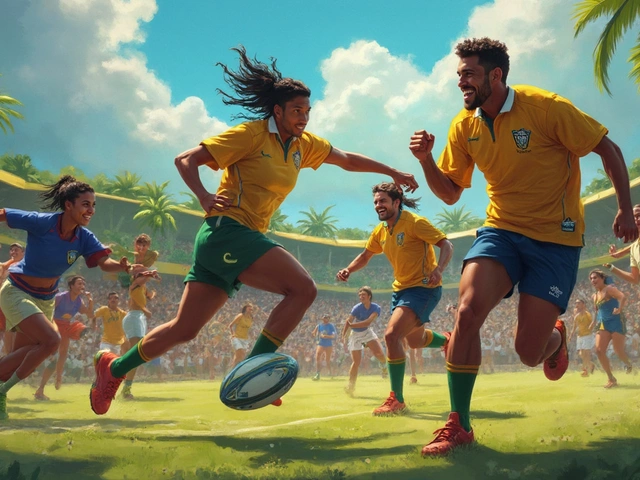Rugby Popularity Potential Calculator
TV Coverage Hours (Weekly)
Hours of regular rugby broadcasts on major channels
Marketing Investment ($M)
Annual global marketing budget for rugby
Rule Complexity (1-10)
Lower = easier for new fans to understand
National Support (1-10)
Government/school support in target countries
Estimated Global Popularity Growth Potential
Key Insight:
Adjust the sliders to see how changes impact rugby's growth potential
Look around any major city on a Saturday afternoon, and you’ll see crowds pouring into football stadiums, fans wearing jerseys, kids kicking balls in parks, and social media buzzing with highlights. Now picture the same scene for rugby. It’s quieter. Smaller. Harder to find. In places like the United States, Canada, or even parts of Asia, rugby doesn’t just lag behind football-it’s barely on the radar. So why is rugby not that popular?
Rugby’s roots are too local
Rugby didn’t spread the way football did. Football’s rules were standardized in England in the 1860s and quickly adopted by British colonies, schools, and navies. Rugby followed a similar path-but only in certain places. You’ll find deep roots in New Zealand, South Africa, Wales, England, France, and Australia. Outside those regions? It’s patchy. In the U.S., for example, rugby was mostly played in elite private schools and universities. It never made the leap to public schools or community leagues the way soccer did. Without that grassroots foundation, it never built the mass following needed to compete with NFL, NBA, or MLB.The sport is too physical for casual fans
Rugby is brutal. Players tackle without pads. They get knocked out. They play through broken bones. A single match can leave 10 or more players injured. That’s not a bug-it’s a feature. But it’s also a barrier. Most casual viewers don’t want to watch a game where someone’s lying on the ground for five minutes while medics rush in. Football has its injuries too, but the stoppages are planned. The hits are choreographed. Rugby is raw. It’s unpredictable. And that scares off families looking for entertainment, not trauma. Broadcasters know this. They don’t push rugby because they know it doesn’t pull ratings like football or basketball.It doesn’t fit TV schedules
Rugby matches last 80 minutes of play, plus stoppages. That’s longer than a football game. But here’s the catch: the clock stops less often. That means fewer commercial breaks. TV networks hate that. They need those ad slots. Football games have 20+ stoppages per half. Rugby has maybe five. That’s why you rarely see rugby on prime-time TV outside of the World Cup. Even then, networks cut away for ads during scrums and lineouts, which breaks the flow. And without consistent TV exposure, it’s impossible to build a loyal fanbase. Kids don’t grow up watching rugby on Saturday mornings because it’s not there.Rugby fixtures are messy and inconsistent
Want to follow a team? Good luck. There’s no single global league. The Six Nations happens in February. The Rugby Championship in August. Super Rugby used to be a thing, but it collapsed. The Major League Rugby in the U.S. plays a 16-game season from February to June. The English Premiership runs from September to May. There’s no unified calendar. Fans can’t know when the next big match is. Compare that to the NFL, where every team plays every week, and the schedule is locked in months in advance. Rugby’s fixture chaos makes it hard for casual fans to get invested. You can’t binge-watch it. You can’t mark your calendar. You can’t talk about it with friends because no one’s watching the same thing.
It’s misunderstood by new viewers
If you’ve never seen rugby before, the first five minutes are confusing. What’s a ruck? A maul? A scrum? Why is the ball always being passed backward? Why do they keep playing after a tackle? Football has simple rules: get the ball in the end zone. Basketball: shoot in the hoop. Rugby? It’s a chain of complex, interconnected actions. You need to understand the offside line, the breakdown, the knock-on rule, the 10-meter rule-all before you can even enjoy the game. Most people give up after two minutes. Football doesn’t require a rulebook to enjoy. Rugby does.The marketing is weak
Look at how the NFL markets itself. Super Bowl ads. Celebrity cameos. Video games. Merchandise. NFL Network. NFL+ streaming. Every team has a social media team that posts daily content. Rugby? The World Rugby organization runs a decent website. Some national unions post match highlights. But there’s no global brand strategy. No viral TikTok challenges. No influencer partnerships. No merch lines in Target. You won’t see a kid wearing a Japan rugby jersey at a mall in Chicago. You won’t see a rugby-themed Fortnite skin. The sport doesn’t feel alive outside its core markets. It feels like a relic.It competes with more popular sports in its own countries
Even in rugby strongholds, it’s not always king. In Australia, AFL and rugby league dominate. In South Africa, football is growing fast among younger fans. In England, football is religion. Rugby union is the sport of old boys’ clubs and public schools. It’s respected, but not always loved. In New Zealand, rugby is huge-but even there, netball and cricket pull in serious viewership. Rugby doesn’t have a monopoly. It’s fighting for attention in markets where it should be dominant. And it’s losing.
There’s no easy path for new fans
Want to start watching rugby? Where do you begin? There’s no go-to streaming service. No beginner’s guide on YouTube that actually works. No app that explains the rules in under five minutes. Compare that to football, where you can open FIFA 25, play a quick match, and instantly understand offsides, fouls, and penalties. Rugby has no on-ramp. No gateway. No “try it for free” experience. You have to already care to get into it. And that’s a death sentence in a world where attention spans are short and options are endless.It’s not about talent-it’s about access
Rugby players are among the most athletic in the world. They run fast, hit hard, and think fast. But talent doesn’t matter if no one sees it. The best rugby players aren’t household names outside their countries. You know Lionel Messi. You know LeBron James. You don’t know Richie McCaw or Beauden Barrett unless you’ve followed the sport for years. Without star power, there’s no emotional connection. And without emotional connection, there’s no fandom. The sport has heroes-but they’re hidden.It’s changing-but slowly
There are signs of hope. Women’s rugby is exploding. The 2021 Women’s World Cup drew over a million viewers in the UK alone. Sevens rugby is faster, more dynamic, and better suited for TV. It’s been added to the Olympics. Major League Rugby is expanding. Japan’s success in the 2019 World Cup sparked interest across Asia. But these are drops in an ocean. Until rugby fixes its scheduling, simplifies its rules for newcomers, and invests in global marketing like the NFL does, it will remain a sport for the faithful-not the masses.What would make rugby more popular?
It’s not about making the game easier. It’s about making it easier to understand. A five-minute explainer video on YouTube that shows a ruck, a maul, and a try with simple graphics. A weekly highlights show on ESPN or Sky Sports that focuses on big hits and last-minute wins. A mobile game that teaches the rules through play. A sponsorship deal with a global brand like Nike or Coca-Cola that puts rugby jerseys in every country. Until then, rugby will keep playing in front of the same 10 million fans-and wondering why the rest of the world isn’t watching.Why doesn’t rugby have a global league like football?
Rugby doesn’t have a global league because it’s governed by regional unions with conflicting interests. The Six Nations, The Rugby Championship, and Super Rugby used to be separate competitions with no unified structure. Attempts to create a true world league failed due to scheduling conflicts, travel costs, and resistance from traditional unions. Without a single, consistent competition, fans can’t build loyalty to teams or players across borders.
Is rugby growing anywhere?
Yes-but only in pockets. Japan has seen a surge since hosting the 2019 World Cup, with youth participation up 30% since 2020. The U.S. has Major League Rugby, which expanded from 7 to 12 teams between 2020 and 2025. Fiji and Samoa are producing world-class talent, and women’s rugby is growing fast in Canada, England, and Australia. But growth is slow, uneven, and still far behind football or basketball.
Why don’t more schools teach rugby?
In many countries, rugby is seen as too dangerous or too expensive. It requires specialized equipment, trained coaches, and large fields. Schools in the U.S. and Canada prefer soccer or flag football because they’re cheaper and safer. Even in Australia and New Zealand, rugby league and AFL often get priority in public schools. Without youth programs, there’s no pipeline for future fans or players.
Does TV coverage affect rugby’s popularity?
Absolutely. Without regular TV exposure, rugby can’t build a mass audience. In countries where it’s shown weekly-like the UK, New Zealand, or South Africa-it’s popular. In the U.S., it’s rarely on free-to-air TV. Even when it is, it’s buried on obscure channels. Football gets prime-time slots, halftime shows, and replays. Rugby gets delayed broadcasts and no promotion. Visibility equals relevance.
Could rugby ever overtake football in popularity?
Unlikely. Football has a 150-year head start, a global infrastructure, and a cultural hold on billions. Rugby’s best chance is to carve out its own space-not as a replacement, but as a complementary sport. Think of it like baseball in the U.S. or cricket in India. It doesn’t need to beat football. It just needs to be visible, accessible, and exciting enough to earn its own loyal following.








